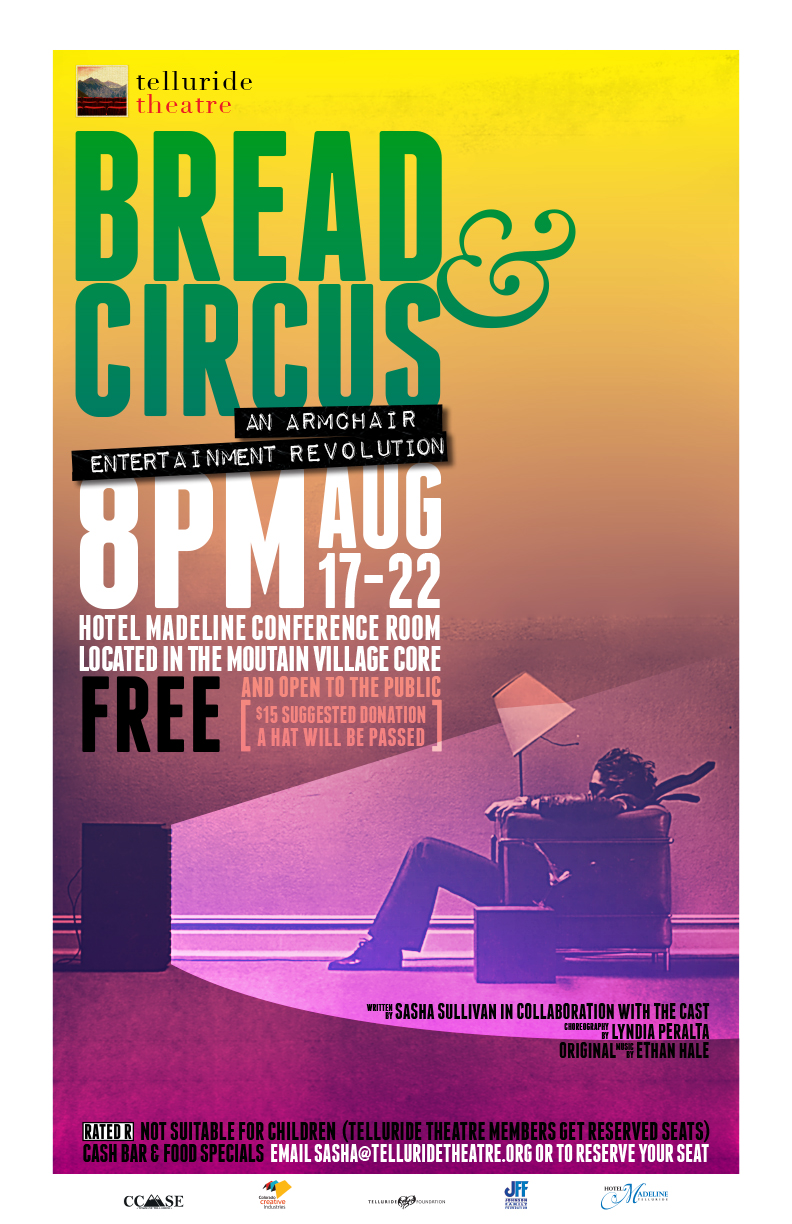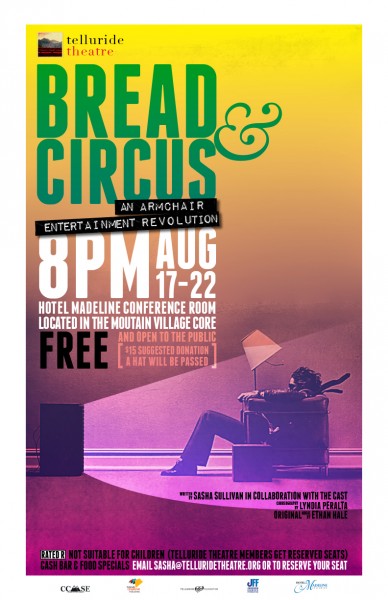
13 Aug Telluride Theatre: “Bread & Circus,” An Insider Lifts the Curtain
“Visionaries, leaders, heroes—those close to the edge of neuroticism—have moved out of the society that would have protected them, and into the dark forest, into the world of fire, of original experience…The courage to face the trials and to bring a whole new body of possibilities into the field of interpreted experience for other people to experience—that is the hero’s deed,” Joseph Campbell
I’ve been asked to write a piece from an insider’s perspective on the process Telluride Theatre uses to create its original plays such as the upcoming “Bread & Circus.” Which is the same as asking me to lean out and wave from the wilderness of a holy place, then beckon you over to take a look.
If you were to peer in during rehearsals, the scene you would see is both plain and eccentric at that same time. Depending on your familiarity with performance processes, you might laugh or feel a little unnerved. You might feel at ease the way you do in your living room. You might think, “Huh, it’s not as glamorous as I’d imagined.”
Our temple (also known as a Telluride Theatre rehearsal space) looks like this: the high school band room is cleared of chairs and sweltering; creatives who call each other family are scattered around the room stretching; notebooks, pencils, and warped, tattered segments of unfinished scripts line the edges of the room. Casual, quick quips and loud chuckling breed more banter and gasp-laughing until our unflappable artistic director, Sasha Sullivan, calls for the warm-up to begin. We jump around, stretch some more, crawl around. We find our breath. We yell and scrunch our faces. Our bodies make sounds. Howls and shuffling slaps fill the room.
Perhaps a group of adults scrambling around a room in a school, rolling and hooting, sounds uncomfortable or seems cliché. Perhaps you’ve found yourself in similar situations—and it looks like home to you. Maybe you want to join us.
If you did, you would feel your sweat and the sensation of pushing against what you thought was possible and acceptable. You would hear Sasha’s voice yelling over music and the din of you and your compatriots:
“Keep going! Do what makes you feel really good!”
You start to sense where everyone is in the room, how each person is moving.
“Beautiful! Now make it bigger!”
You feel your body and the collective body, all the contradicting textures—running, whipping, pouring, jumping.
“Don’t think! No planning—just do what your body is feeling!”
All the tempos, the breaths—they start to synch into a moving sculpture no one will ever see.
See? Plain and eccentric, ordinary and wild. But what is it for? What does all the hopping and hollering do? How does a show get made?
Exercises like this help us get back in our bodies, which for me means remembering that the body doesn’t lie. And then remembering how good it feels to follow, without restraint, truth-telling impulses and the bliss of shedding inhibition and domineering thought.
It’s in the romp that we get free.
After the warm-up, we talk about the general plot and aesthetic we’re working with, then break into smaller groups. Each group is sent out on 10- or 20-minute improvisational missions. Caroline and I sit in the hallway writing vicious diatribes for a scene; Anna dictates her hilarious monologue to Patrick. Sam and Cat write a song, while Stephanie and Lyndia build another 28-counts of dance. At the end of the 15 minutes, we meet up again and present what we made while Sasha films. We’re sent out on more assignments; we film again. Rinse and repeat for four hours. At the end of the night, we go home. Sasha reviews the footage and transcribes some of the bits, pulls ideas out of others, and weaves them together to write a version of a script. The version presented at the next rehearsal will be one of at least seven.
After weeks of collaborative discussion and improvising, searching for the right feeling, following risky, silly impulses, throwing away volumes of unfitting material, we have a script (which will continue to shape-shift until we perform). We add blocking and sound and lights. We make more choices about our characters.
By the time we perform, we’ve found a thing we were looking for. I say “a” thing because the show could have unfurled in many different iterations. When we make work in this way, we follow bliss, we journey, and we come to bliss. The in-between, the journey, may not always look blissful or comfortable or pretty. That’s because sincere bliss requires an honest eye and a willingness to go out and brave the wild of unformed creative energy. With Telluride Theatre, I gratefully find myself in the company of savvy heroes who are adept in adventuring and trusting that, even though we don’t know what it looks like, we will find it.
Editor’s note: Telluride Theatre’s “Bread & Circus,” is an original play by artistic director Sasha Sullivan in collaboration with the cast & crew. Curtain, 8:00 pm, August 17-22, in the Hotel Madeline ballroom in Mountain Village. Free, though a $15 donation is greatly appreciated. To become a member (and get prime seats for all shows), click here.
“Bread & Circus” was written by Sasha Sullivan in collaboration with the cast, in a six-week process. This is Telluride Theatre’s (and Sasha’s) seventh year creating and premiering an original show in Telluride.
Directed by Sasha Sullivan
Choreography by Lyndia Peralta
Original music by Ethan Hale
Featuring: Sam Burgess, Cat Lee Covert, Patrick Dyar, Gin Eborn, Caroline Grace Moore, Stephanie Osan, Anna Robinson, Colin Sullivan and the writer of this wonderful story, Marissa Mattys.



Sorry, the comment form is closed at this time.